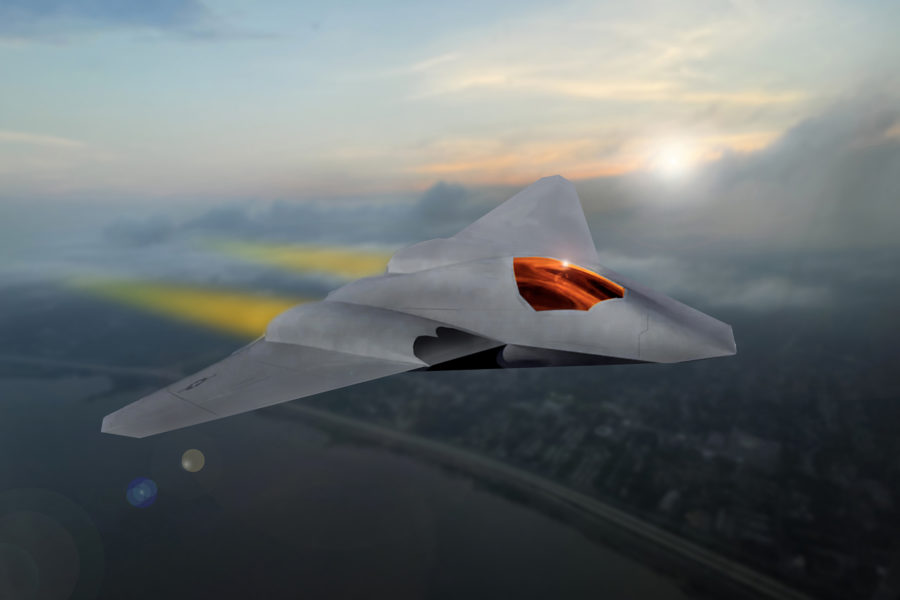There was a secret, multi-agency X-plane program to explore future fighters that paved the way for the Next-Generation Air Dominance program, Air Force Secretary Frank Kendall revealed at the POLITICO Defense Summit on Nov. 14.
Although Kendall and other Air Force officials have previously said there were flying prototypes before the current stage of the NGAD program, his new remarks provided more details about the highly classified project, including the agencies involved, some of the money spent, and the fact that the NGAD will control the uncrewed fighters escorting it. He also noted that the uncrewed Collaborative Combat Aircraft program won’t get started until the fiscal 2024 defense bill is passed.
The Air Force said in May that it expects to award an NGAD contract in 2024. Kendall has previously said the NGAD will cost “multiple hundreds of millions” of dollars per tail.
Asked what most excites him about the NGAD, Kendall said it is the inclusion of a “family of systems” in the program, which includes autonomous escort platforms, new weapons—including the secret AIM-260 Joint Advanced Tactical Missile—and “offboard sensors.”
In 2014, when Kendall was undersecretary of defense for acquisition, technology, and logistics, “we commissioned a study” led by the Defense Advanced Research Projects Agency called “The Dominance Initiative,” he explained.
“That study lasted a year or so,” Kendall said, and recommended a “family of systems” to accompany the crewed fighter that will succeed the F-22.
In 2015, “we started the Next Generation Air Dominance X-plane program,” he said, which was funded for about $1 billion. The costs were split—“a third by DARPA, a third by the Air Force and a third by the Navy.”
That program “produced some prototypes that were successful demonstrating the technologies we need,” he said. His use of the plural suggests there were competitive designs in that stage of the project, but he did not disclose whether there were two, three, or more.
Industry sources have said that Boeing and Lockheed Martin have been involved in NGAD, but Northrop Grumman chief executive officer Kathy Warden recently said her company won’t bid on the Air Force version of the program. However, she did indicate Northrop will pursue the Navy’s counterpart advanced fighter, which is also known as NGAD, or F/A-XX. The services have said they are not attempting a joint program like the F-35.
Former Air Force acquisition executive Will Roper revealed in 2020 that an NGAD prototype had flown, but didn’t explain how many, or that the flying demonstrators were “X-planes.” The term “X-planes” generally indicates platforms that are exploring new, previously unfielded technologies on an air platform, while a “Y-plane” is generally a prototype of a specific platform which, with some refinement, will be put in production.
The Pentagon selected the F-35 at the conclusion of an X-plane competition between Lockheed Martin, with the X-35, and Boeing, which offered the X-32. Those X-planes explored combining supersonic flight with short takeoff and vertical landing capabilities and stealth, as well as new manufacturing techniques.
The NGAD as now structured “is the combination of aircraft—a crewed aircraft [and] unmanned aircraft—that will have some of those technical characteristics we demonstrated could be done,” Kendall said. He did not elaborate on what new technologies were explored, but Pentagon sources have previously said the level of stealth on the NGAD is orders of magnitude improved over that of the F-22 and F-35.
The addition of uncrewed Collaborative Combat Aircraft controlled by NGAD will allow that one manned platform to ‘fight as a formation, basically,” Kendall said. CCAs are building on the progress of other Pentagon and partner efforts like the Air Force’s Skyborg program, the Air Combat Evolution program under DARPA, and Boeing’s work with Australia on the MQ-28 Ghost Bat.
“All of those coming together convinced me that we were ready to make a commitment to this kind of capability,” Kendall said.
CCA is slated to receive $5.8 billion in funding over the next five years, with Kendall calling it “one of the most important [programs] I’m waiting on funding for.” Production will come toward the end of the five-year cycle, around fiscal 2028—that is, “if we can get started,” Kendall said, referring to the delay in starting the new program under the continuing resolution funding the government.
“This family of systems approach we’re taking—also in the mix [is] our new weapons like the JATM, Joint Advanced Tactical Missile, which we’ll get into production in the next few years—[will create] a very formidable next generation, air dominance set of capabilities,” Kendall said. “I think when we get that package filled, I’m really looking forward and excited about seeing that come to life.”
